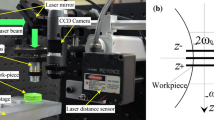Abstract
Analysis of the experimental data presented in Part I of this paper and those available in the literature revealed that the mechanism of material removal in laser machining of chemically vapour-deposited diamond is a two-step process: diamond transforms to graphite, and subsequently graphite sublimates. The energy fluence required for the formation of graphite is much lower than its removal by sublimation, and both are sensitive to the wavelength of the laser beam, the impurities present in the film and the environment during machining. When a 248 nm excimer laser beam interacts with diamond, there is an energy loss of 20% by reflection and 10% by transmission. The remaining 70% energy is used for heating the diamond, converting diamond to graphite, and sublimating graphite. Graphite is removed mostly by physical ablation and to some extent by chemical oxidation with the ambient.
A theoretical calculation based on bond strength estimates that the threshold energy fluence for the ablation of diamond is 0.37 J cm-2. The experimental energy fluence was 0.8 J cm-2. Experimental results on the material removal rates as a function of energy fluence closely follow the Beer–Lambert equation, suggesting that physical ablation is the determining mechanism. Temperature calculations showed that both diamond and graphite tend to oxidize in a single laser pulse that contributes to the material removal.
Similar content being viewed by others
References
W. L. Smith, Opt. Engng 17 (1978) 489.
J. Luxon and D. Parker, “Industrial lasers and their applications, 2nd Edn (Prentice-Hall, Englewood Cliffs, NJ, 1992).
P. D. Ownby and R. W. Stewart, in “Engineered materials handbook”, edited by T. Reinhart (American Society for Metals, Metals Park, OH, 1987) pp. 821–834.
T. P. Thorpe, A. A. MorrisH, L. M. Hanssen, J. E. Butler and K. A. Snail, in “Diamond optics III”, Proceedings of the SPIE, Vol. 325, edited by A. Feldman and S. Holly (Society of Photo-Optical Instrumentation Engineers, Bellingham, WA, 1990) pp. 230–237.
J. Wilks and E. Wilks, “Properties and applications of diamond” (Courier, Boston, MA, 1991).
H. D. Gresser, Society of Manufacturing Engineers, Dearborn, MI, Technical Paper MR76-855 (1976).
M. Rothschild, C. Arnone and D. J. Ehrlich, J. Vac. Sci. Technol. B 4 (1986) 310.
M. Rothschild and D. J. Ehrlich, J. Vac. Sci. Technol. B 5 (1987) 389.
T. V. Kononenko, V. I. Konov and V. G. Ralchenko, in “Diamond optics V”, Proceedings of the SPIE, Vol. 1759, edited by A. Feldman and S. Holly (Society of Photo-Optical Instrumentation Engineers, Bellingham, WA, 1992) pp. 106–114.
V. I. Konov, V. G. Ralchenko, S. M. Pimenov, A. A. Smolin and T. V. Kononenko, in “Laser microprocessing of diamond and diamond-like films”, Proceedings of the SPIE, Vol. 2045, Laser processing of thin films and microstructures, edited by I. Boyd (Society of Photo-Optical Instrumentation Engineers, Bellingham, WA, 1994) pp. 184–192.
V. P. Ageev, L. L. Builov, V. I. Konov, A. V. Kuzmichev, S. M. Pimenov, and A. M. Prokhorov, Dokl. Akad. Nauk SSSR 303 (1988) 598.
D. H. Douglas-Hamilton and E. D. Haag, J. Opt. Soc. Amer. 64 (1974) 36.
S. Prawer, R. Kalish and M. Adel, Appl. Phys. Lett. 48 (1986) 1585.
V. I. Konov, T. Kononenko, S. Pimenov, A. Smolin and N. Chapliev, Sov. J. Quantum Elec. 21 (1991) 112.
A. P. Malshe, S. T. Kshirsagar and K. S. Chari, Mater. Lett. 11 (1991) 175.
H. O. Pierson, “Handbook of carbon, graphite, diamond and fullerenes” (Noyes Publications, Park Ridge, NJ, 1993).
M. von Allmen, “Laser–beam interactions with materials, 2nd Edn (Springer, Berlin, 1995).
C. P. Christensen, in “Lasers as tools for manufacturing”, Proceedings of the SPIE, Vol. 2062, edited by L. Migliore and R. Walker (Society of Photo-Optical Instrumentation Engineers, Bellingham, WA, 1993) pp. 14–21.
C. P. Christensen, Ind. Laser Rev. June (1994) 9.
G. H. Pettit and R. Sauerbrey, Appl. Phys. A 56 (1993) 51.
Author information
Authors and Affiliations
Rights and permissions
About this article
Cite this article
Windholz, R., Molian, P.A. Nanosecond pulsed excimer laser machining of chemically vapour-deposited diamond and graphite: Part II Analysis and modelling. Journal of Materials Science 33, 523–528 (1998). https://doi.org/10.1023/A:1004308921860
Issue Date:
DOI: https://doi.org/10.1023/A:1004308921860




